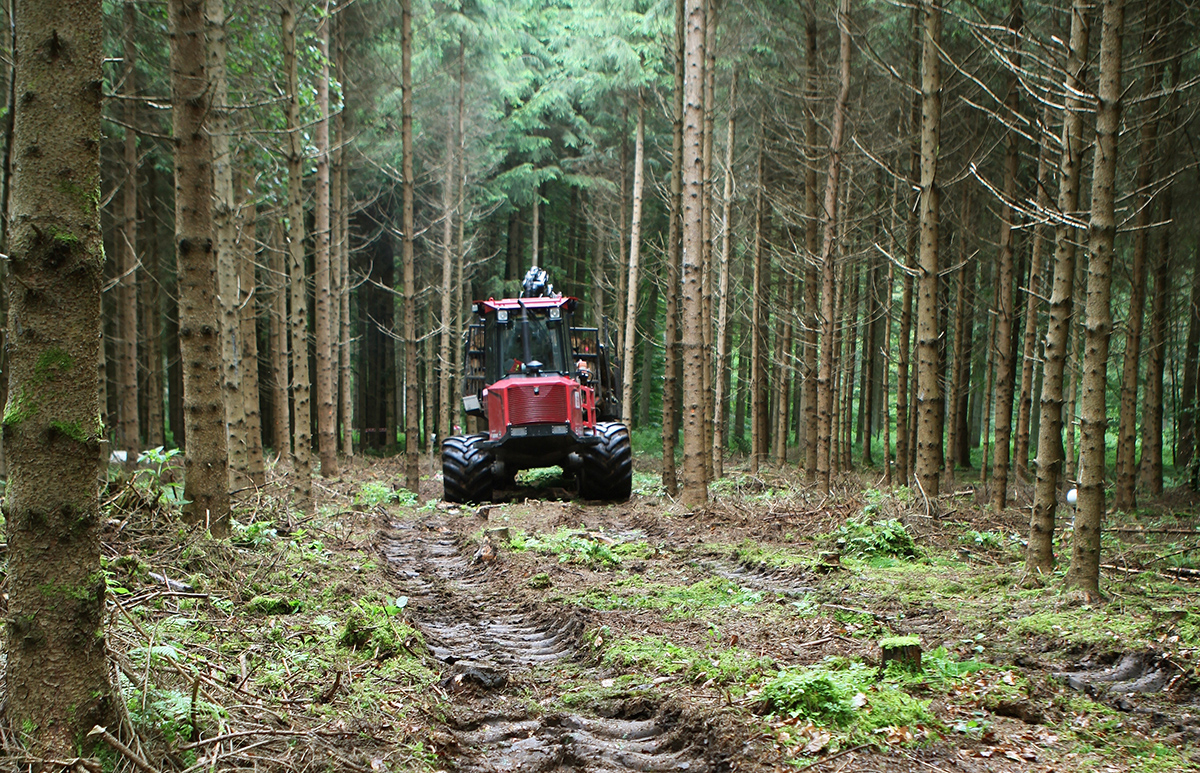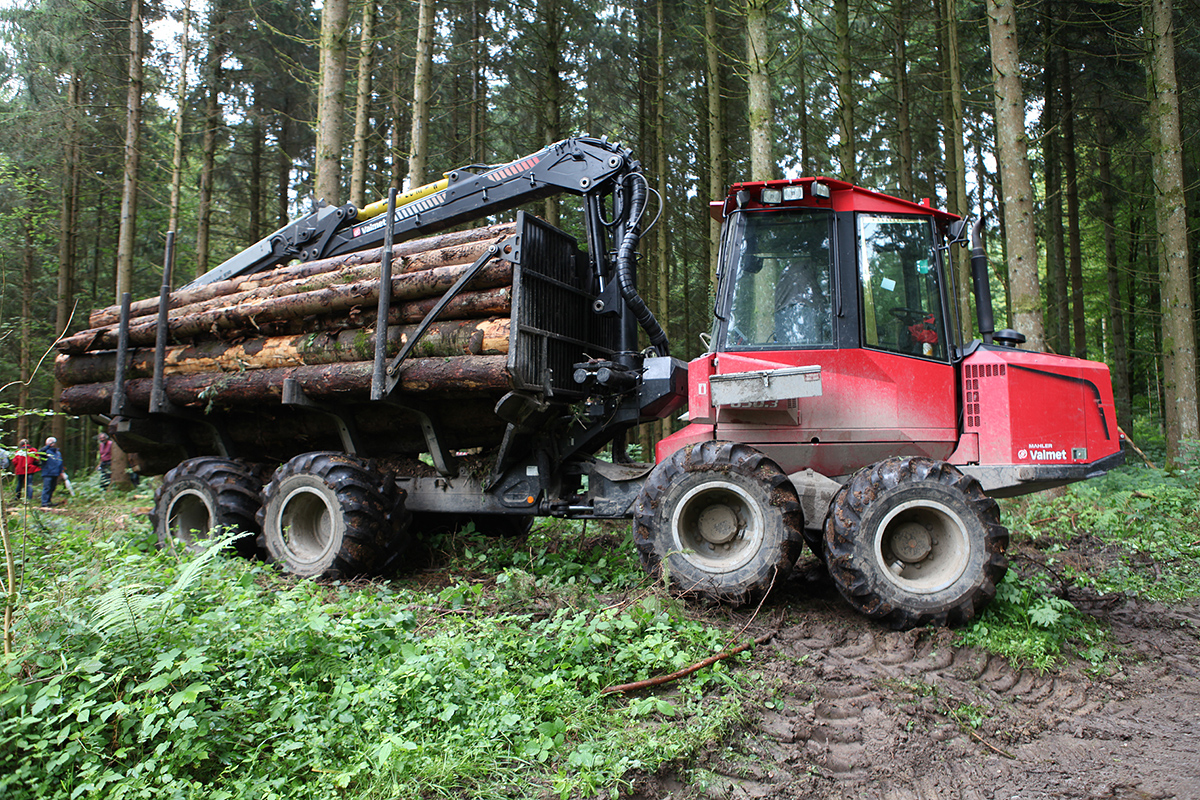Participants in training courses on protecting the soil during timber harvesting often ask whether it would be less damaging to the soil in logging trails if vehicles were only loaded to half-capacity during timber extraction, and twice as many trips were made. The Swiss Federal Institute for Forest, Snow and Landscape Research WSL tested this in practice and came to the conclusion that such an approach might lessen soil compaction, but would not necessarily reduce tyre track depths.
In recent years, participants in WSL's soil protection courses have asked time and again whether half-loading vehicles during timber extraction would have less of an impact on the soil in areas with high soil moisture content. A lower axle load is generally expected to result in less soil compaction extending less far down into the soil.
However, if a certain quantity of timber must be transported, half-loading the extraction vehicles would require twice as many trips to be made. Practical observations and experiences suggest that this tends to have a rather negative impact on tyre track formation. However, in most cases, there was no specific data available on the conditions in which reduced-load transportation took place: there were hardly any information on the soil structure, the soil properties, the soil moisture content, the vehicle’s operating weight or the exact number of trips made.
With that in mind, WSL decided to conduct a case study on the subject at the Wagenrain forest holding in Bremgarten (canton of Aargau). A drive-over test was held on two adjacent logging trails in comparable – and, most importantly, known – conditions in order to answer the following two questions:
- What effect does driving over a logging trail with a half-loaded vehicle, but making twice as many trips, have on soil compaction and tyre track formation?
- What differences are there between driving over forest soil for the first time and driving over an existing – and thus pre-compacted – logging trail?
Test facility
The test was held on two existing logging trails in a woodruff beech forest with woodrushes (fig. 2, trails 1 and 2). The logging trails in question were last used around 10 years ago. The researchers also decided to create a new trail on forest soil that had never been driven on before (trail 0). This trail was placed between the two existing trails and designed to have comparable conditions so as to highlight the differences between first-time and repeated driving over soil.
The soil in the test area was deep, low-skeletal, acidic cambisol or luvisol with substantial backwater influence in places. For the most part, the grain size corresponded to sandy silt.
One section with high soil moisture content ('WG hoch') and one with low soil moisture content ('WG niedrig') were set up on all three trails. The soil moisture content in the 'WG niedrig' sections was determined entirely by the weather: at the time of the drive-over test (June 2013), it was approximately 25%, which is actually quite high. In the 'WG hoch' sections, the soil moisture content was brought close to the soil’s liquid limit (approx. 33%) through the addition of more water.
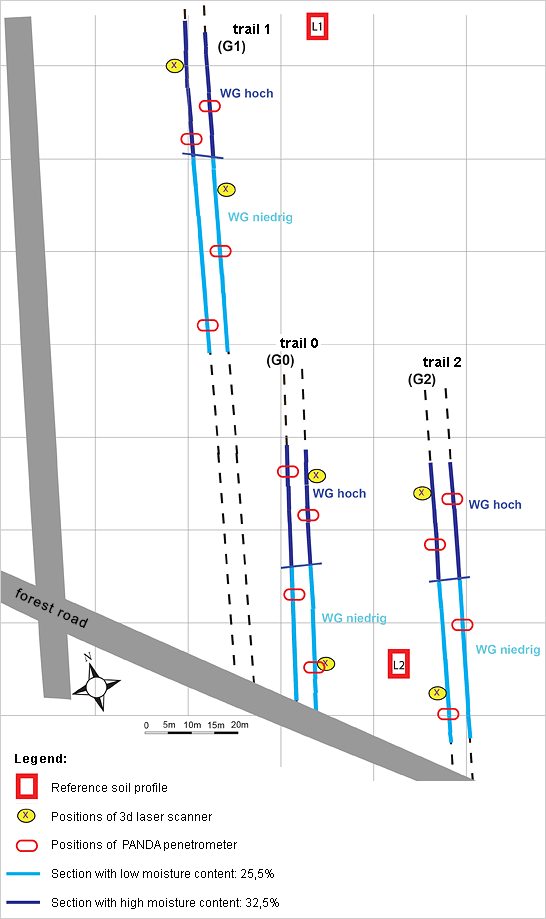
Fig. 2 - Facilities for the drive-over test: G0 = new trail/full load, two trips; G1 = existing trail/full load, four trips; G2 = existing trail/half load, eight trips
The test vehicle drove over trail 1 four times with a full load, and over trail 2 eight times with a half load. It also drove over trail 0 – that is, over forest soil that had never been driven on before – twice with a full load. The state of the tyre tracks was determined through visual checks and physical soil tests both before and after the vehicle had driven over them:
- Soil core specimens were taken for the purposes of performing physical and mechanical soil tests in the laboratory (soil density, pore space, pre-compaction, air and water conductivity).
- A PANDA penetrometer was used to test the penetration resistance – namely, the force that must be applied to penetrate the soil with a metal cone – of each section, both before and after the vehicle had driven over them. This test makes it possible to determine the extent and depth to which the soil was compacted by being driven over.
- The tyre tracks were visually classified as belonging to category 1, 2 or 3 before and after being driven over.
- The WSL’s Remote Sensing Research Group also documented the tyre tracks with a 3D laser scanner before and after the vehicle drove on them (fig. 3).
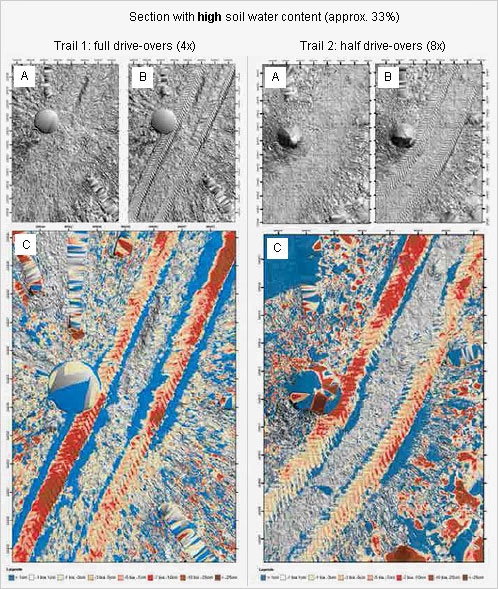
Fig. 3 - Terrestrial laser scan for the sections with high soil moisture content. Image A shows the tyre track situation before the trail was driven over, while image B shows the situation after the trail was driven over (in relief). Image C shows the calculated height differences between images A and B. The colour shifts from yellow to red to brown to show increasing tyre track depth, while blue indicates ridges (not graduated to show height increases). Deep tyre tracks (red to brown) with ridges (blue) on both sides are hallmarks of category-3 tyre tracks.
Less compaction with half-loaded vehicles
The following soil parameters were tested:
- Soil density
- Pore volume
- Air and water conductivity
- Pre-compaction (soil elasticity)
- Penetration resistance
At both depth levels, the soil density was higher when the vehicle travelled fully-loaded than when it travelled half-loaded (fig. 4). Correspondingly, the pore volume was also lower following the fully-loaded trips. Air and water conductivity declined slightly at both full load and half load. There were no significant differences in pre-compaction (a measure of soil elasticity) after the soil had been driven over. This indicates that the logging trails gain a certain degree of stability as a result of the compaction that comes from being driven over in the past. As expected, penetration resistance was largely higher after the fully-loaded trips than after the half-loaded trips. Stones and roots in the soil resulted in a few implausible measurements.
Conclusion: Even when more trips are made, half-loading vehicles results in less soil compaction and the soil is not compacted to such a great depth.
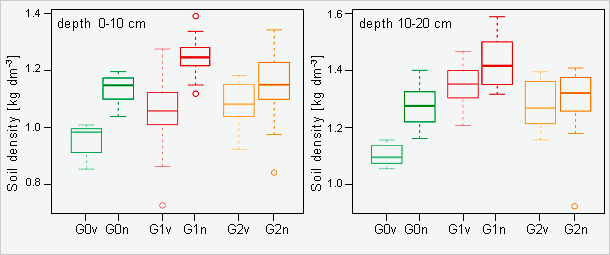
Fig. 4 - Soil density for each of the trails before (v) and after (n) they were driven over. The density was measured in the topsoil, at depths of 0-10 cm and 10-20 cm. G0 = new trail, being driven on for the first time/2x full load; G1 = existing trail, 4x full load; G2 = existing trail/8x half load.
No clear result regarding tyre track formation
In the sections with low soil moisture content (approx. 25%), the vehicle’s load (full load or half load) made almost no difference to tyre track formation. In the sections with high soil moisture content (33%, approaching the soil’s liquid limit), there tended to be less tyre track formation when the vehicle was half-loaded, but the case study did not allow a definite conclusion to be drawn.
However, when Wöstefeld (2011) performed a comparable experiment with eight-wheeled forwarders at two different locations whose soils showed backwater influence (southern Black Forest: sandy silt; northern Black Forest: slightly silty sand), the opposite conclusion was reached: in this case, partial loads and more trips resulted in deeper tyre tracks. Further experiments would need to be conducted on land with a different soil structure in order to provide a reliable answer to the question of tyre track formation.
Wöstefeld’s research work in the Black Forest also looked into how partial loads and more trips affected tyre track formation when the forwarder was equipped with four machine tracks (tracks with wide plates were fitted to the rear axle). Despite the increased number of trips, driving with machine tracks and partial loads resulted in less tyre track formation. This could be ascribed to the greater contact surface of the machine tracks (compared to the vehicle’s wheels) and the reduction in slippage while driving.
Conclusion: Based on findings to date for wheeled vehicles, half-loads during timber extraction cannot be recommended as a means of reducing tyre track formation.
Important: low soil moisture content when soil is first driven over
In addition to the existing logging trails (trails 1 and 2), another trail, trail 0, was created on soil that had been driven on before (fig. 2) in a bid to highlight the differences encountered when forest soil is driven on for the first time, as opposed to one of many times. Driving over soil for the first time changes its structure more dramatically than driving over it again when it has already been pre-compacted. As expected, the soil in the section with high soil moisture content experienced greater compaction than the soil in the section with low soil moisture content. Moreover, tyre track formation was more pronounced on the section with high moisture content in trail 0 (which had not been driven on before) than in trail 1 (an existing logging trail).
These findings confirm that if soil is to be driven over for the first time (e.g. in the case of a new logging trail), this should be done in favourable conditions, i.e. when the soil moisture content is low. This will create a better starting position for future trips over the soil.
Consequences for practice
This practical experiment showed that, as expected, using a half-loaded vehicle during timber extraction results in less soil compaction and limits the depth of compaction. However, the measure's effect on tyre track formation is questionable. Although the weight of the load is halved, the full weight of the vehicle itself cannot be reduced, meaning that the vehicle’s total operating weight is only around a quarter lower while the number of trips is doubled. When the soil moisture content is high, this can be just as unfavourable for tyre track formation as a high load weight.
Nevertheless, half-loading vehicles during timber extraction may be an effective measure in certain situations, such as when the soil moisture content is increasing (i.e. it has started to rain) and an extraction operation still needs to be completed. However, when the soil moisture content approaches the liquid limit, even driving with a partial load will result in category-3 tyre tracks, so work should be suspended.
Finally, it is important to note that working with half loads makes timber extraction significantly more expensive. Wöstefeld (2011) calculated that the additional costs would be 30% higher for half-load timber extraction by forwarder in the two test areas in the Black Forest.
Literature
- Wöstefeld, J.H., 2011: Auswirkungen von Bändern und Teillasten auf die Erhaltung der technischen Befahrbarkeit von Rückegassen auf befahrungsempfindlichen Standorten. Masterarbeit, Albert-Ludwigs-Universität Freiburg i.Br., 107 S.
Translation : TTN Translation Network

